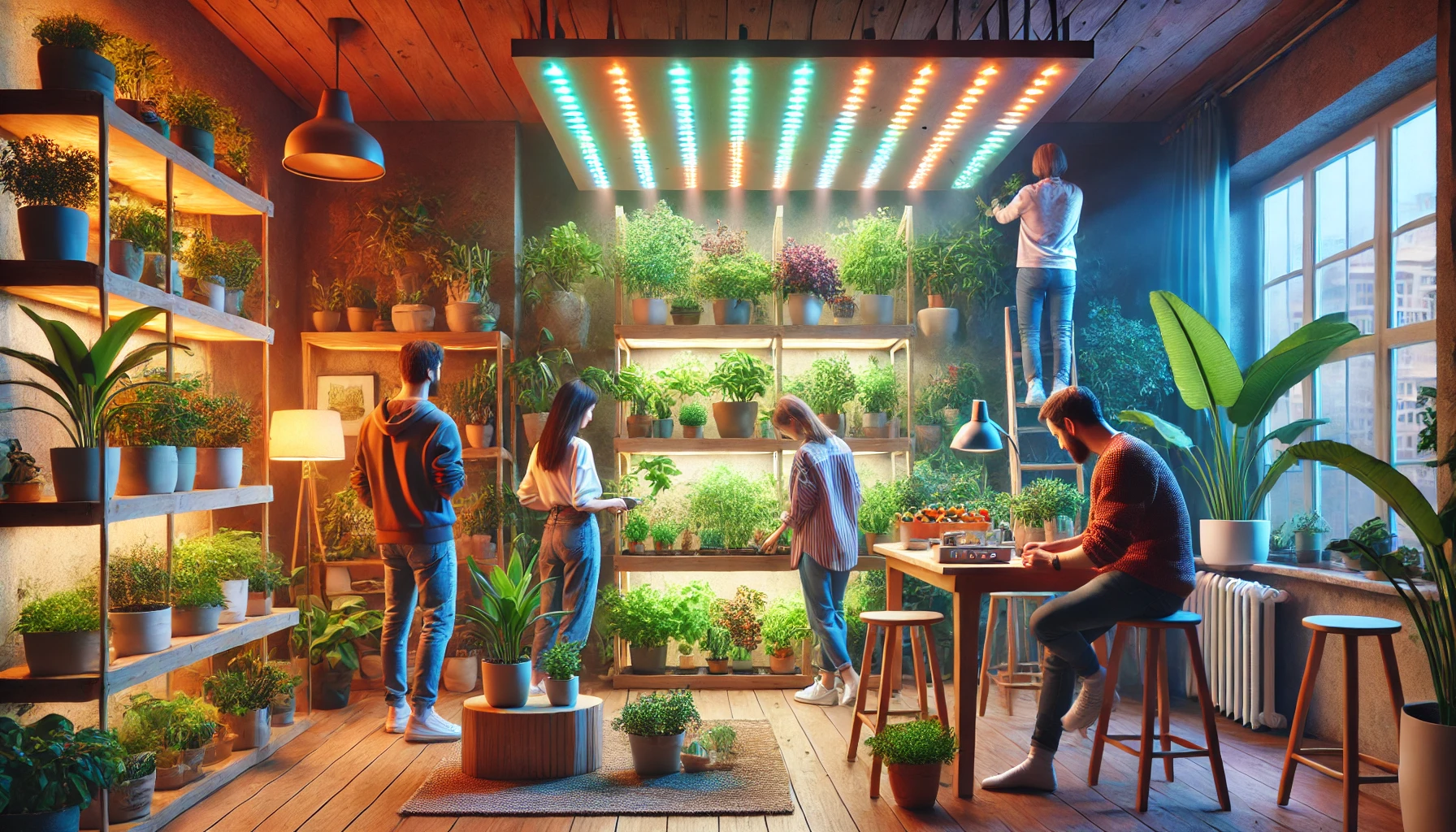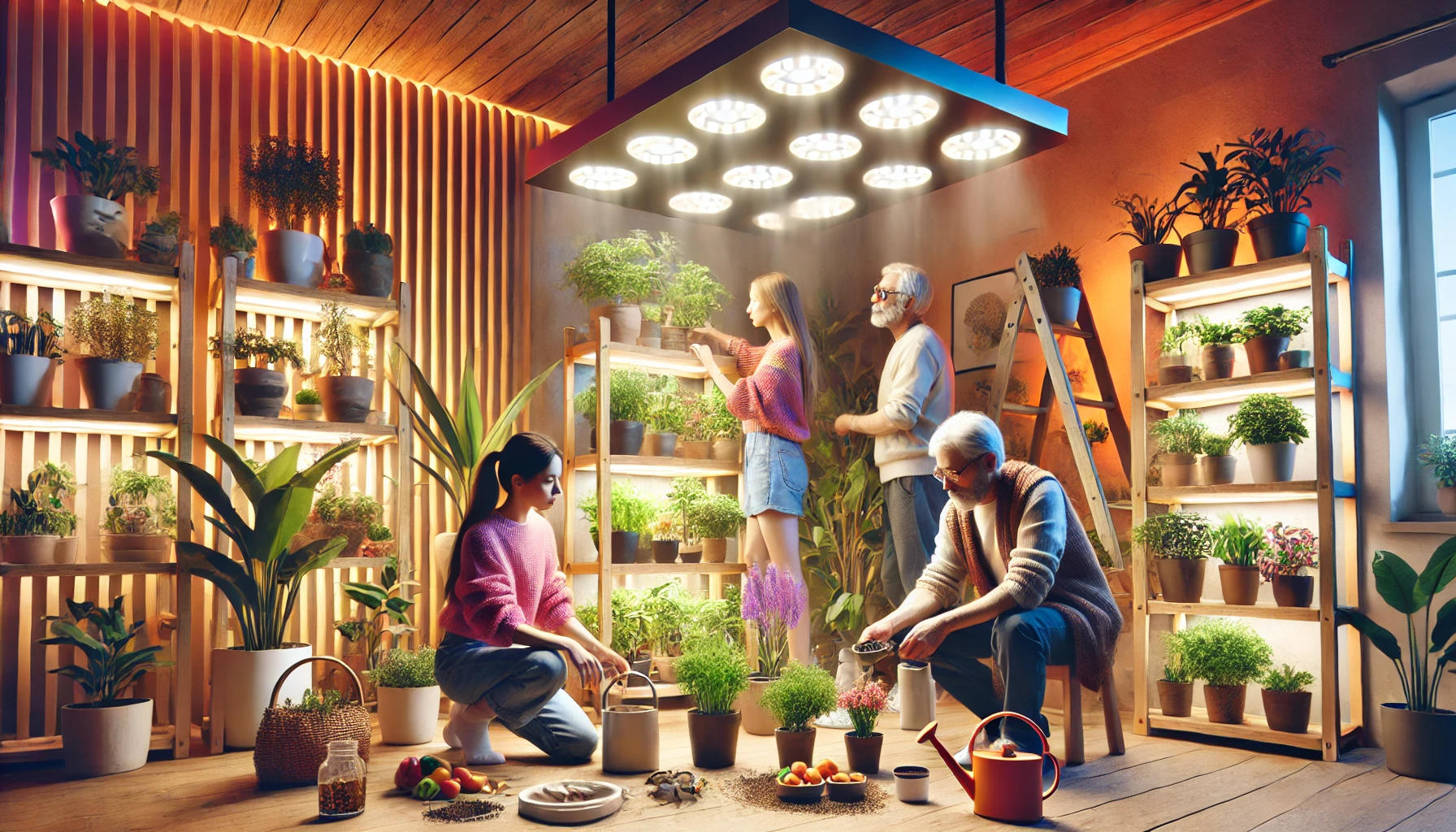Indoor plants bring beauty, freshness, and a sense of tranquility to any space. However, ensuring they receive adequate light can be challenging, especially in homes with limited natural sunlight. This is where Indoor Plant Lighting Kits come into play.
These kits are specially designed lighting systems that provide the necessary light spectrum for healthy plant growth. They mimic natural sunlight, allowing plants to photosynthesize effectively even in dimly lit rooms or spaces without windows.
Why is Proper Lighting Essential for Indoor Plants?
Lighting is one of the most critical factors in plant health. Light fuels photosynthesis—the process where plants convert light energy into food. Without sufficient light, plants become weak, leggy, and may eventually die.
By using an indoor plant lighting kit, you can:
- Ensure year-round growth for your plants.
- Enhance leaf color, flowering, and fruit production.
- Maintain plant health even in dark environments.
- Give plants a stable, controlled light source.
With advancements in lighting technology, modern indoor lighting kits are energy-efficient, user-friendly, and tailored to different plant needs. But with so many options available, how do you choose the best one?
What is the Best Indoor Lighting for Houseplants?
When choosing the best indoor lighting for houseplants, it’s essential to understand the differences between natural sunlight and artificial lighting.
Natural Sunlight vs. Artificial Lighting
Natural sunlight is the ideal source of light for plants because it provides a full spectrum of wavelengths, including blue and red light, which are crucial for plant growth.
However, not all homes or apartments receive sufficient direct sunlight, especially during winter months or in rooms with limited window access.
Artificial lighting serves as a substitute, but not all types of light work equally well for plants. Some indoor lights lack the necessary spectrum for proper growth, which is why grow lights are specifically designed to provide plants with optimal wavelengths.
Factors to Consider When Choosing Indoor Lighting
When selecting an indoor plant lighting kit, consider these key factors:
- Light Spectrum: Look for full-spectrum lights that include both blue (for leafy growth) and red (for flowering and fruiting).
- Light Intensity: Different plants have varying light needs. Low-light plants like pothos require less intensity than high-light plants like succulents.
- Light Duration: Some plants need 12–16 hours of light per day, so choosing a timer-equipped grow light can be beneficial.
- Energy Efficiency: LED grow lights consume less electricity and last longer than traditional bulbs.
Best Indoor Lighting Options for Houseplants
Fluorescent bulbs, such as T5 and T8 tubes, are an affordable and effective option for leafy plants, but they are less intense than LED grow lights.
Incandescent bulbs, while inexpensive, generate too much heat and are not ideal for plant growth. HID (High-Intensity Discharge) lights are used in commercial plant growing but may be excessive for household use due to their high energy consumption and heat output.
For most indoor plant enthusiasts, LED grow lights are the best choice due to their efficiency, versatility, and ability to provide a full light spectrum.
Can Any LED Light Be Used as a Grow Light?
While LED lights are widely used for home and office lighting, not all LEDs are suitable for plant growth.
How Are Regular LEDs Different from Grow Lights?
Standard LED bulbs are designed to provide white light for human vision, but they don’t always include the full spectrum needed for plant photosynthesis. On the other hand, LED grow lights are engineered with specific wavelengths to support plant growth.
Here’s what sets LED grow lights apart from regular LEDs:
- Full Spectrum Lighting – Includes red, blue, and sometimes infrared and ultraviolet light.
- Higher PAR Value – Photosynthetically Active Radiation (PAR) is the range of light wavelengths that plants use for photosynthesis. Regular LEDs may not emit enough PAR.
- Balanced Intensity – Grow lights are optimized to prevent excessive heat, unlike standard LEDs, which may not distribute light evenly.
How to Choose the Right LED Grow Light for Plants
When selecting an LED grow light, keep the following in mind:
- Full Spectrum: Look for bulbs labeled “full-spectrum” or “broad-spectrum.”
- Wattage & Intensity: For larger plants, choose LEDs with higher wattage or adjustable brightness.
- Coverage Area: Ensure the light covers the required space, especially if you have multiple plants.
- Timer Function: Automating your light schedule can help maintain consistent growth cycles.
Best LED Grow Lights for Indoor Plants
- GE BR30 LED Grow Light – Budget-friendly, full spectrum, ideal for small plants.
- Spider Farmer SF-1000 – High-efficiency, great for larger plants or multiple pots.
- VIPARSPECTRA P1000 – Adjustable light intensity with an excellent balance of blue and red light.
- Mars Hydro TS 1000 – Energy-efficient, perfect for hydroponics and indoor gardens.
Effectiveness of Grow Lights for Indoor Plants
Indoor gardening has surged in popularity, and with it, the need for effective lighting solutions has become crucial. Grow lights have revolutionized indoor plant care, enabling enthusiasts to cultivate everything from leafy greens to vibrant flowers within their homes.
But how effective are grow lights compared to natural sunlight? Let’s dive into the science behind plant energy absorption, case studies comparing different lighting sources, and real-life success stories from indoor plant lovers.
Understanding the Science Behind Plant Energy Absorption
Plants rely on photosynthesis to convert light into energy, enabling growth, flowering, and fruiting. Sunlight provides a full spectrum of light, covering all wavelengths necessary for optimal plant health.
However, indoor plants often receive limited natural light due to seasonal changes, shaded windows, or unsuitable home layouts. This is where grow lights come in.
Different types of grow lights emit specific wavelengths of light that plants need. Blue light encourages strong vegetative growth, while red light stimulates flowering and fruit production. Full-spectrum light mimics natural sunlight and is best for overall plant health.
Advancements in LED technology have made grow lights more efficient, providing targeted wavelengths without excessive heat or high electricity costs associated with older models like incandescent or fluorescent bulbs.

Case Studies on Grow Lights vs. Natural Light
Several studies have analyzed plant growth under artificial lighting versus natural sunlight. A study conducted by the University of Arizona found that tomato plants grown under high-quality LED grow lights produced nearly the same yield as those grown in natural sunlight, provided they received the correct spectrum and duration of light.
Similarly, research from NASA has shown that plants can thrive in artificial environments under controlled lighting, supporting the feasibility of space farming.
These studies confirm that, while sunlight remains the ideal source, grow lights can replicate natural conditions well enough to sustain healthy plant growth.
Success Stories from Indoor Plant Enthusiasts
Indoor plant lovers worldwide have shared remarkable success stories using grow lights. An urban gardener in New York transformed a dimly lit apartment into a lush indoor jungle with strategically placed LED grow lights.
Another hydroponic enthusiast in Chicago successfully grew fresh herbs year-round in a basement using full-spectrum lights, significantly reducing grocery costs.
Gardeners often report that grow lights extend the growing season, allowing for fresh produce and thriving greenery even in winter months. With the right setup, anyone can create an ideal plant-friendly environment indoors.
How to Illuminate Indoor Plants Effectively
Setting up grow lights correctly is essential to maximize their benefits. Here’s a step-by-step guide to installing indoor plant lighting kits and some expert tips for optimizing light exposure.
Step-by-Step Guide to Setting Up Indoor Plant Lighting Kits
Choosing the right grow light type is the first step. LED grow lights are the most energy-efficient and offer a full spectrum. Fluorescent lights, such as CFL or T5 tubes, work well for seedlings and herbs. High-intensity discharge (HID) lights are powerful but best suited for large-scale growing.
Determining proper placement is just as important as choosing the right light. Small plants should have lights positioned about six to twelve inches above them, while larger plants need a spacing of twelve to twenty-four inches. Placing lights too close can result in overheating and foliage damage.
Setting a light schedule ensures plants receive consistent exposure. Most plants need twelve to sixteen hours of light per day. Using a timer can help automate lighting and prevent human error.
Proper ventilation prevents overheating and ensures even light distribution. Using fans or keeping plants in an open space encourages better airflow, which helps maintain overall plant health.
Monitoring plant growth is key to long-term success. Regularly checking for signs of too much or too little light, such as yellowing leaves or leggy growth, allows for necessary adjustments in light height and duration.
Tips for Maximizing Light Exposure
Rotating plants regularly ensures all sides receive equal light, preventing uneven growth. Using reflective surfaces such as aluminum foil or whiteboards can help distribute light more effectively. Supplementing with natural light when possible is also beneficial.
If a sunny window is available, combining grow lights with daylight exposure can enhance plant growth and reduce electricity costs.
Seasonal Considerations for Lighting Adjustments
Plants’ lighting needs change with the seasons. During winter, when daylight hours are shorter, increasing artificial light exposure helps compensate for the lack of sunlight. In summer, if natural light is abundant, reducing grow light usage prevents excess heat buildup. Tailoring light schedules to seasonal conditions ensures year-round plant health and growth.
Conclusion and Final Tips
Quality lighting is one of the most crucial factors in maintaining thriving indoor plants. Whether growing food, flowers, or decorative greenery, using the right grow lights can dramatically improve plant health and yield.
Grow lights effectively mimic natural sunlight, supporting healthy growth indoors. Full-spectrum LEDs offer the best balance of efficiency, cost, and plant benefits. Proper setup, light scheduling, and seasonal adjustments are essential for success.
For those looking to invest in grow lights, researching reputable brands and choosing models suited to specific plant needs is a smart approach. Regularly monitoring plant responses and making necessary adjustments will ensure optimal results.
Have you experimented with grow lights? Share your experiences and tips in the comments below! Let’s create a thriving community of indoor plant enthusiasts.


I love this article, very interesting and well structured. I must admit I was not aware of the lighting kit for indoor plants! LED grow lights seems to be the best which provides a full light spectrum. Which colour in more beneficial?
What is the common mistake people make when using artificial lighting for houseplants?
Thank you! I’m glad you found the article interesting and well-structured. Yes, LED grow lights are a fantastic option since they provide a full light spectrum that mimics natural sunlight.
When it comes to colors, blue light (400-500nm) is essential for vegetative growth, helping plants develop strong leaves and stems, while red light (600-700nm) promotes flowering and fruiting. A balanced full-spectrum LED is usually the best choice for overall plant health.
One common mistake people make with artificial lighting is placing the lights too far or too close to the plants. If the light is too far, plants may become leggy due to insufficient light. If it’s too close, it can cause leaf burn. Another mistake is not providing the right photoperiod—most plants need 12-16 hours of light per day with a period of darkness to rest.
Do you have any houseplants you’re thinking of growing under artificial light?
Unfortunately I don’t have the space for them, but I have friends that might be interested in that. I will definitely pass the information on.